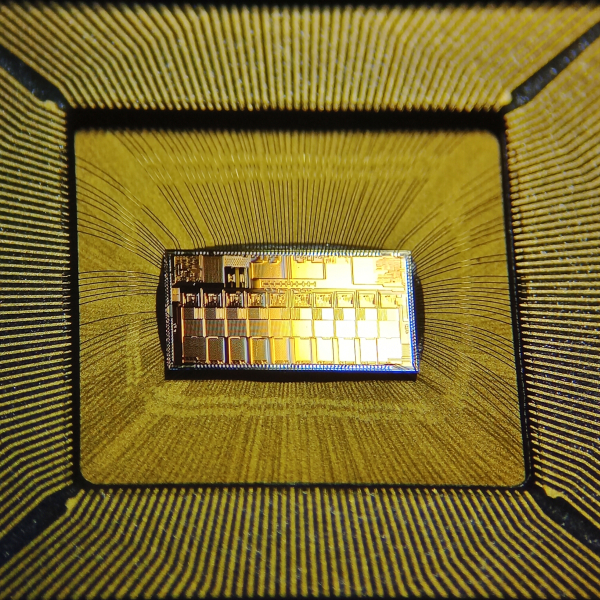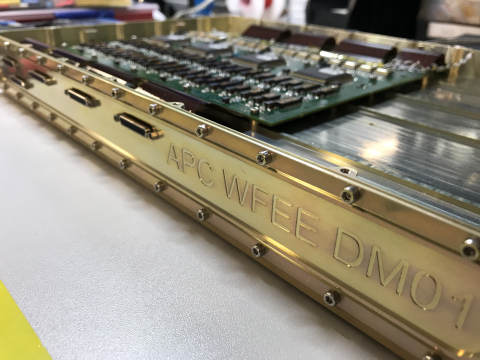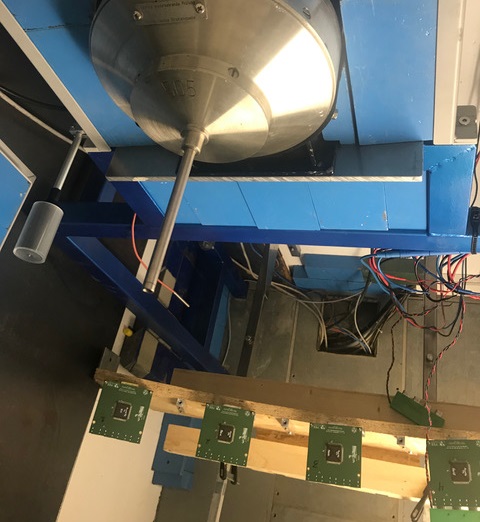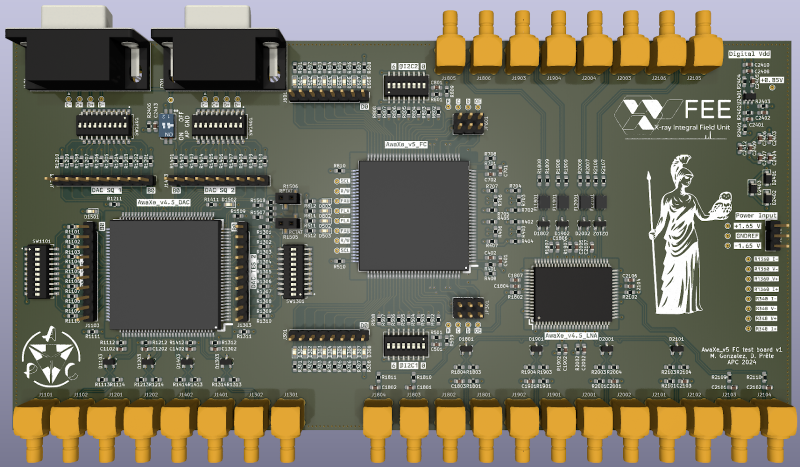
I. The Athena Mission and instruments
II. ATHENA@APC: WFEE for XIFU
III. News
IV. The team
V. Publications and presentations
VI. Outreach
I. The Athena mission and instruments
The ATHENA mission (Advanced Telescope for High ENergy Astrophysics) is the second long-range space mission (L2) of the long term program Cosmic Vision of the European Space Agency (ESA). This mission is dedicated to the scientific theme The hot and violent Universe which it plans to explore with the launch of a large X - ray observatory designed by a consortium of European institutes, particularly in France, Germany and Italy, and with US and Japanese participation. In June 2014, it was selected by the ESA Science Program Committee (SPC) for the second large mission opportunity. In November 2023, the mission was redefined (“NewAthena”). The SPC recognized that NewAthena is a flagship mission of the ESA science program.

Figure 1: A conceptual design for the Athena spacecraft derived from the ESA CDF study, designed to be accommodated in an Ariane 6 launcher. – credit ESA.
The ATHENA observatory will be composed by a large X-ray telescope with a 12-m focal length which collects X-rays between 0.5 and 12 keV with an angular resolution of about 5-10 arcsec and a large effective area of 1.4 m^2 at 1 keV, using an innovative technology; the SPO mirrors (Silicon Pore Optics) developed by ESAa, and two focal plane instruments:
- A large field spectral-imager (40'x40') with a spectral resolution of 150 eV: the WFI (Wide Field Imager).
- A very high resolution spectral-imager (2.5 eV FWHM), the X-IFU (Integral Field Unit)
These telescope and focal plane instruments will provide observational capabilities two orders of magnitude greater than the instruments of the previous generation. ATHENA will allow spectacular advances in all fields of astrophysics, thanks in particular to the very large collection area, the good angular resolution combined with the large field of view, and, above all, the exceptional spectral resolution of 2.5 eV of the X-IFU spectrometer.

Athena's main objectives are to provide answers to two fundamental questions of the Hot and Violent Universe scientific theme:
- How does matter come together in the universe to form the large structures that are observed (galaxies and galaxy clusters)?
- How do giant black holes form and grow and what effects do they have on the evolution of the universe?
This observatory will provide unique contributions to the study of the high-energy universe, in particular in the domain of compact objects (black hole, neutron star, white dwarf), transient sources, supernova remnants, pulsar nebulae, the physics of galaxy clusters and active galactic nuclei (AGN), the warm plasmas in the interstellar medium, stars and also some phenomena in the solar system.
Several of those are of interest in the APC laboratory, in particular in the "Astrophysique de Haute Energie" and "Cosmologie" groups:
- The galactic center region and its super massive black-hole;
- Galactic compact objects;
- Particle acceleration and interaction processes;
- Variability and spectroscopy of AGN;
- Galaxy clusters and large cosmology surveys,
- Transient high energy sky and multi-messenger astronomy.
Finally, the third long-range space mission (L3) will be dedicated to the study of the gravitational universe with the instrument LISA which also has an APC contribution. Both ATHENA and LISA will be in orbit around 2033-2038 and synergy between them will give Europe a strong position for the multi-messenger exploration of the universe.
- The DC bias of the superconducting sensors (TES)
- The low noise amplification of the signal right outside the cryostat
- The adjustment of the superconducting readout chain (SQUID stages) operating points
Hence, the developed circuit has low noise architecture and very low gain drift.


- November 2023 - Total Ionizing Dose tests completed on AwaXe_v4.

- March 2024 - Reception of AwaXe_v5FC, AwaXe_V4.5DAC and AwaXe_v4.5LNA ASIC prototypes.\

APC participates to Athena in the frame of the French contribution to the mission and in particular within the X-IFU Consortium. APC Athena team members are:
Project responsibles
- Andrea GOLDWURM (APC Scientific responsible, Science co-Investigator for X-IFU)
- Damien PRELE (APC WFEE Project manager, APC WFEE System Engineer, Instrument co-Investigator for X-IFU and Detection-chain team member)
- Eugenio DAMBRAUSKAS (Project Control Engineer)
Scientific team
- Alexis COLEIRO (E2E simulator, ground segment WFEE)
- Peggy VARNIERE (WP2, WP2.5, E2E simulator)
- Stefano GABICI
- Régis TERRIER
- Léna ARTHUR (PhD student LabEx UnivEarths / Université Paris Cité)
- Jonathon BAIRD (PostDoc LabEx UnivEarths / Université Paris Cité)
- Raphaël MIGNON-RISSE (PostDoc CNES)
- Floriane CANGEMI
- Pier-Alex DUVERNE
Instrument team (WFEE)
- Si CHEN (Micro-electronics design)
- Bernard COURTY (Command control)
- Alain GIVAUDAN (Mechanics conception)
- Manuel GONZALEZ (Instrument Scientis X-IFU WFEE)
- Mael LE CAM (Mechanics)
- Jean LESREL (Electrical Avionic)
- Jean MESQUIDA (Micro-electronics layout)
- Michael PUNCH (Instrumentalist)
- Luis Horacio ARNALDI (Instrumentalist)
- Bao TON (PhD)
Support team
- Stéphane DHEILLY (Mechanics workshop)
- Lydie PAVILI-BALADINE (Administration)
- Beng KY (Electronics)
APC associated scientists
- James BARTLETT
- Jacques DELABROUILLE
- Paolo GOLDONI
- Etienne PARIZOT
- Michel PIAT (Instrumentation)
- Yi ZHANG (Invited professor)
Roles of APC scientists in Athena
- Several team scientists are members of the Athena Science (and Mission) Working Groups.
- A. Goldwurm is IN2P3 contact point for the Athena project.
V. Publication and presentation
- Piro L., …, Coleiro,A., et al., 2021, Multi-messenger-Athena Synergy White Paper, Edited by: Francisco J. Carrera and Silvia Martínez-Núñez on behalf of the Athena Community Office.
- S. Chen, D. Prêle, B. Courty, F. Voisin and J. Mesquida, ATHENA Warm ASIC for the X-IFU Electronics, SPIE Astronomical Telescopes + Instrumentation 2020
- D. Prêle, S. Chen, A. Coleiro, P. Varnière, P. Peille, L. Ravera and C. Kirsch, Warm Front End Electronic Modelization \\ for the X-IFU ATHENA Readout Chain Simulation, SPIE Astronomical Telescopes + Instrumentation 2020
- S. Chen, D. Prêle, F. Voisin, P. Laurent, A. Goldwurm, Dynamic Base Current Compensation for Cascaded Bipolar Low Noise Amplifier , Sensors & Transducers, ISSN 1726-5479, Vol. 235, Issue 7, International Frequency Sensor Association Publishing IFSA Publishing, S. L., July 2019, pp. 23-30
- S. Chen et al., RHBD for WFEE of XIFU/ATHENA Space Observatory, SERESSA, 2018.
- S. Chen et al., Development of the WFEE Subsystem for the XIFU Instrument of the ATHENA Space Observatory, SPIE Space Telescopes and Instrumentation, 2018.
- D. Barret et al., The Athena Xray Integral Field Unit (XIFU), SPIE Space Telescopes and Instrumentation, 2018.
- D. Prêle et al., SiGe Integrated Circuit Developments for SQUID/TES Readout, Journal of Low Temperature Physics, 2018.
- S. Chen et al., Amplificateur bas bruit à faible dérive de gain en technologie BiCMOS AMS SiGe 350 nm, Ecole IN2P3 de Microélectronique, 2017
- D. Prêle et al., Total dose (up to 100 krad) testing of a 0.35 BiCMOS SiGe technology, Ecole IN2P3 de microélectronique, 2017.
- D. Barret et al., The Athena Xray Integral Field Unit (XIFU), SPIE Space Telescopes and Instrumentation, 2016.
- T.L. Trong et al., XIFU technical challenge, SPIE Space Telescopes and Instrumentation, 2016.
- D. Prêle et al., Gain drift compensation with no feedbackloop developed for the XRay Integral Field Unit/ATHENA readout chain, Journal of Astronomical Telescopes, Instruments, and Systems, Vol. 2(4), 2016.
- D. Prêle, Frontend Multiplexing applied to SQUID multiplexing, Journal of Instrumentation, Volume 10, 2015.
- Nandra P., … [Bartlett J., Beckmann V., Delabrouille J., Gabici S., Giraud-Heraud Y., Goldoni P., Goldwurm A., Laurent P., Parizot E., Prêle D., Terrier R., Varnière P.], et al., 2014, Athena: The Advanced Telescope for High ENergy Astrophysics : A mission addressing the Hot and Energetic Universe Science Theme, proposition de concept de mission L2 ESA, April 2014
- Mignon-Risse, R. et al (2023) "On the origin of the lump in circumbinary discs," MNRAS, 520, 1285-1295 - 2023MNRAS.520.1285M
- Mignon-Risse, R. et al.. (2023) "Impact of a binary black hole on its outer circumbinary disc," MNRAS, 519, 2848-2861 - 2023MNRAS.519.2848M
- Didier Barret, Andrea Goldwurm, Damien Prêle, Florence Ardellier, Alexis Coleiro, Stefano Gabici, Manuel Gonzalez, Jean Lesrel, Régis Terrier, Peggy Varnière, et al. The Athena X-ray Integral Field Unit: a consolidated design for the system requirement review of the preliminary definition phase, Instrumentation and Methods for Astrophysics - Experimental Astronomy (2023) 55:373–426, https://doi.org/10.1007/s10686-022-09880-7
- Gilles Roudil, François Pajot, … Damien Prêle, … et al., Status of the end-to-end demonstration readout chain for Athena/X-IFU, Preprint for JLTP, Nov 2023 DOI: 10.21203/rs.3.rs-3544860/v1
- M. Gonzalez et al., Impedance matching between SQUID and warm amplifier for TES readout in TDM, Preprint for JLTP, Nov 2023 DOI: 10.21203/rs.3.rs-3547516/v1
- D. Prele et al. Conceptual design and analysis of a cryogenic front-end ASIC for TES readout using ST-130 nm BiCMOS technology, submitted for JLTP
- S. Chen, et al, 10 ppm/K BiCMOS Temperature-compensated Current Source, Proceeding MiCDAT2023, p34-38 https://sensorsportal.com/MicDAT_2023/MicDAT_2023_Proceedings.pdf
- B. Ton, et al, High Sensitivity On-chip BiCMOS Thermometer with Differential Output and Offset Nulling, p47-51 https://sensorsportal.com/MicDAT_2023/MicDAT_2023_Proceedings.pdf
- H. Geoffray, H. Fossecave, E. Bellouard, P. Peille, C. Daniel, O. Maisonnave, E. Guilhem, B. Jackon, B. Doriese, M. Durkin, J. van der Kuur, B.-J. van Leeuwen, M. Kiviranta, D. Prêle, L. Ravera, Y. Parot, The cryo-harness technology for the Athena X-IFU detection chain, aussi soumis pour publication dans JLTP
- Accretion/Ejection Talks for PhD and postdocs working on numerical simulations -- https://www.youtube.com/@accretion-ejectiontalks5319
- https://www.the-athena-x-ray-observatory.eu/outreach/nuggets/54-outreach/nuggets/812-athenanuggets-37-specific-integrated-circuit-for-the-x-ifu-warm-front-end-electronics.html
- D. Prêle and A. Goldwurm: Know more about the APC contribution, The XIFU Gazette N°7, April 2018.
Links
- ESA website: http://www.cosmos.esa.int/web/athena/home
- Athena consortium (IRAP): http://www.the-athena-x-ray-observatory.eu/

